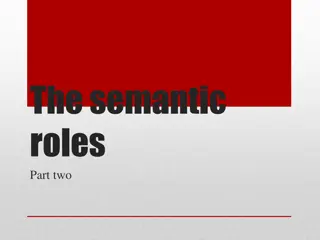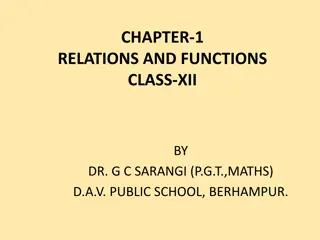Understanding Semantic Relations in Language
In semantics and pragmatics, sense relations are categorized into paradigmatic, syntagmatic, and derivational axes. Paradigmatic relations involve semantic choices within a sentence structure, while syntagmatic relations connect items within the same sentence. Examples include synonymy, hyponymy, meronymy, antonymy, and more, illustrating the intricate web of meaning in language.
Download Presentation

Please find below an Image/Link to download the presentation.
The content on the website is provided AS IS for your information and personal use only. It may not be sold, licensed, or shared on other websites without obtaining consent from the author. Download presentation by click this link. If you encounter any issues during the download, it is possible that the publisher has removed the file from their server.
E N D
Presentation Transcript
Chapter 8 & 9 Introduction to Semantics & Pragmatics
8.1.3 Varieties of sense relations Sense relations situate themselves on one of three major axes: paradigmatic, syntagmatic, or derivational.
8.1.3.1 Paradigmatic relations Paradigmatic relations reflect the semantic choices available at a particular structure point in a sentence. For instance: I'll have a glass of . beer wine water lemonade etc. Typically, paradigmatic relations involve words belonging to the same syntactic category, although not infrequently there are minor differences: We bought some . knives forks spoons Cutlery Here, cutlery is a mass noun, whereas all the others in the list are count nouns.
Paradigmatic sense relations In principle, paradigmatic relations may hold between members of any of the major syntactic categories. The following are examples involving verbs and adjectives respectively: John across the field, ran walked crawled I'd like a glass of sherry. dry sweet Notice that the pairs knives/forks, knives/cutlery, and dry/sweet exemplify different paradigmatic sense relations.
8.1.3.2 Syntagmatic relations Syntagmatic relations hold between items which occur in the same sentence. For instance, it is by virtue of syntagmatic sense relations, in this case between adjective and head noun, that I'd like a glass of dry sherry is normal, whereas I'd like a glass of striped sherry is odd.
Paradigmatic Relations (TWO TYPES) Synonymy Hyponymy Meronymy Inclusion & Identity Antonymy Exclusion & opposition
8.2.1 Hyponymy We say that apple is a hyponym of fruit, and conversely, that fruit is a superordinate (occasionally hyperonym) of apple. FRUIT Apple Inclusion Extensionally Apple intensionally inclusion FRUIT
8.2.2 Meronymy Another relation of inclusion is meronymy (part- whole relation). Examples of meronymy are: hand: finger, teapot: spout, wheel: spoke, car: engine, telescope: lens, tree: branch, and so on. It is a relation of inclusion (intensionally & extensionally) because a hand physically includes the fingers; but the meaning of finger somehow incorporates the sense of hand (Langacker).
8.2.3 Synonymy Synonyms are words whose semantic similarities are more salient than their differences. Two types 8.2.3.1 Absolute synonymy 8.2.3.3 Near-synonymy
8.2.3 Synonymy 8.2.3.1 Absolute synonymy Absolute synonymscan be defined as items which are equinormal in all contexts. Examples are sofa:settee and pullover: sweater. 8.2.3.3 Near-synonymy Near-synonyms can contrast in certain contexts. For example, consider the following:
8.2.3 Synonymy 8.2.3.3 Near-synonymy (iii) big: large He's a big baby, isn't he? (+) He's a large baby, isn't he? (-) (v) die: kick the bucket Apparently he died in considerable pain. (+) Apparently he kicked the bucket in considerable pain. (-)
Chapter 9: Paradigmatic Sense Relations of Exclusion & opposition (antonymy) Antonyms: words that are opposite in meaning. Complementary: dead x alive Gradable: happy x sad Converses (relational opposites)
Converses This is a special type of antonymy in that the members of a pair do not constitute a positive-negative opposition. They show the reversal of a relationship between two entities.
Converses Reciprocal social roles employer x employee Kinship relations husband x wife Temporal relations before x after Spatial relations in front of x behind
Antonyms (in terms of their structure) Markedness (two types) 1. Morphological markedness: one member of the opposition carries a morphological 'mark' that the other lacks. This mark is most frequently a negative prefix: possible: impossible happy: unhappy kind: unkind true: untrue
2. Distributional markedness The unmarked term according to this conception is the one which occurs in the widest variety of contexts or context-types. By this criterion it could be argued that long is unmarked with respect to short because it occurs in a variety of expressions from which short is excluded: This one is ten metres long. What is its length? How long is it? (neutral question)
Chapter 12 Syntagmatic Relations
12.1 Normal and abnormal co- occurrence It is necessary to make a distinction between two types of interaction between meaningful elements in a discourse. We shall distinguish the two types by the terms discourse interaction and syntagmatic interaction.
Discourse Interaction (I) John and Mary will be joined in holy matrimony next week: who's going to get the spuds? There are two sorts of oddness here. The first is the register clash between holy Matrimony and spuds. This can easily be cured: (2) John and Mary will be joined in holy matrimony next week: who is going to get the potatoes? But we are still left with the difficulty of finding the relevance of potatoes to John and Mary's marriage. (There would be no problem if potatoes was replaced by confetti, or even, rice.) These are both aspects of discourse interaction
Syntagmatic Relations 12.2 Types of abnormality Two basic types of abnormality resulting from the combination of two senses can be distinguished. The first is where meanings simply do not 'go together'; the second is when one meaning adds nothing new to another one with which it is combined and thus appears unnecessary, or redundant. We shall call these clash and pleonasm, respectively.
12.2.1 Semantic clash The first distinction is between clashes which result from the non-satisfaction of collocational preferences, and those which result from the non-satisfaction of selectional preferences (dissonance). This latter distinction between collocational and selectional preferences depends on whether the preferences in question are an inherent consequence of propositional content or not. 1. inappropriateness: If a collocational preference is contravened, we may say that inappropriateness results: inappropriateness is then the lowest degree of clash. My geraniums have kicked the bucket.
12.2.1 Semantic clash If what is here called a selectional preference is contravened (dissonanace), the clash is more serious. 2. Paradox Paradox is also evident in the following: It's too small to fit into this box, Rain falls upwards, usually, If you walk any faster, you'll be standing still. Paradoxes are typically 'correctable'.
12.2.1 Semantic clash 3. Incongruity. The most serious degree of clash is This is when the discrepancy is so large that no sense can be extracted at all. There is no feeling that the utterance could be corrected. Examples are: purple gestures of rat milk the sky's nipple is a dictionary
12.2.2 Pleonasm A pleonastic relation between two elements occurs when one of them seems redundant. So, for instance: (3) John kicked the ball with his foot. Pleonasm can be avoided either by omitting with his foot: (4) John kicked the ball. or by replacing kick with strike: (5) John struck the ball with his foot.
12.2.2 Pleonasm Notice, however, that (6) is not pleonastic: 6) John kicked the ball with his left foot. This is because the phrase with his left foot now contains new information. In some cases, repetition has an intensifying, rather than a pleonastic effect: (9) That is very, very good. (10) Mary rushed quickly to the window. Notice that the idea of "quickly" is part of the meaning of rush, which is why we get a paradox if we qualify an act of rushing with the opposite term: (11) ?Mary rushed slowly to the window. (clash)
12.5 Syntagmatic and paradigmatic relations 12.5.1 Pleonasm In cases of pleonasm, the oddness can in general be 'cured' by substituting one of the words by a hyponym or hyponymous expression, or the other by a superordinate. (18) He kicked it with his foot. (pleonastic) He kicked it with his left foot. (normal: left foot is hyponymous to foot) He struck it with his foot. (normal: struck is superordinate to kick
12.5 Syntagmatic and paradigmatic relations 12.5.2 Clash The severity of a clash can be roughly estimated by examining the minimal change required to cure it. Inappropriateness is a type of clash which can be cured by substitution of one of the words by a propositional synonym: (19) The geranium passed away. (inappropriateness) The geranium died. (normal: died is a propositional synonym of pass away) Paradox is a more serious type of clash which can be cured by substituting one of the words by an incompatible or immediate superordinate: (20) It's too small to fit into this box. (paradox) It's too big to fit into this box. (normal: big is an incompatible of small) Incongruity is an incurable clash: (21) powdered thrills
12.8 Co-occurrence patterns between words It is a commonplace observation that words prefer some partners to others. And some dictionaries take it upon themselves to impart what they call 'collocational information' to their readers.
Reasons for collocational behavior of words 12.8.1 Extralinguistic factors Some of the possible reasons for the greater affinity of A for X rather than Y are not located in the language at all, but in the extralinguistic world. For instance, one reason why Jane fried the egg is more frequent than Jane fried the lettuce. A further governing factor is significance: to what extent does it matter whether something is old or not? It makes a great deal of difference (generally) whether a man is old or young, but not a tree.
Reasons for collocational behavior of words 12.8.2 Stereotypic combinations A factor leading to collocational affinity which lies on the border between the linguistic and the non-linguistic is the existence of stereotypic combinations, such as the co-occurrence of beautiful with flower(s), or dear with friend.
Reasons for collocational behavior of words 12.8.3 Default patterns A number of factors leading to collocational affinity are, of course, part of the language. (50) X was last night under intense pressure to resign. Here, the meaning of intense would be equally well conveyed by strong or extreme, but is significantly more likely. Similarly, fresh allegations (cf. new allegations), gross negligence (cf. great negligence), etc.
To recap. Discourse interaction rules can be violated through Register clash Violation of cultural norms Syntagmatic interaction Pleonasm Semantic clash rules can be violated through
To recap. Semantic clash Non-satisfaction of selectional preferences (incongruity) Non-satisfaction of collocational preferences Non-satisfaction of selectional preferences Cannot be corrected (inappropriateness) (paradox) Correctable Correctable























